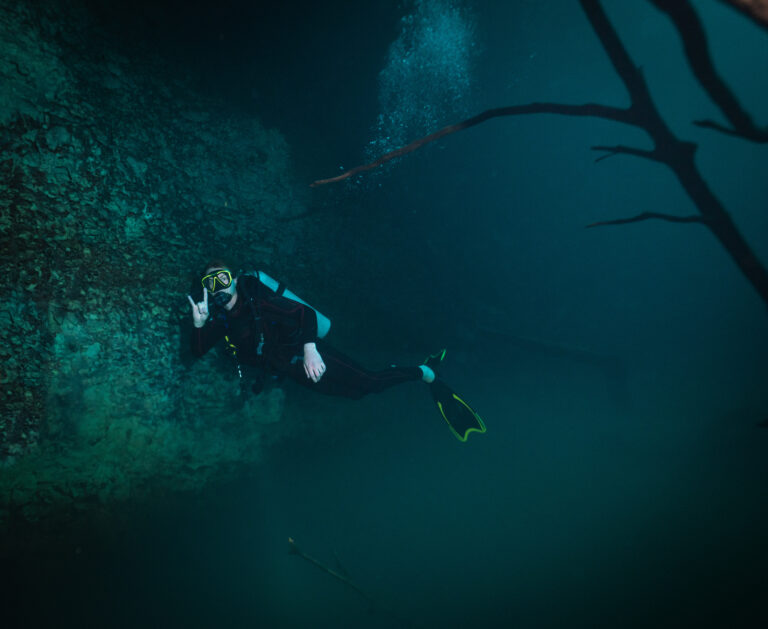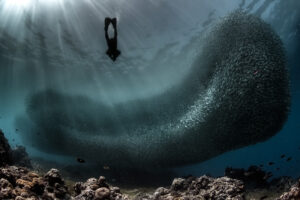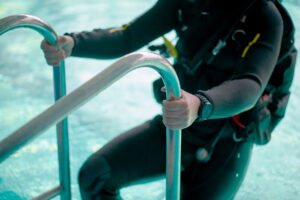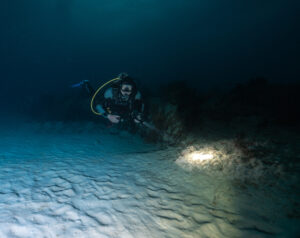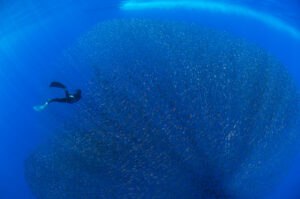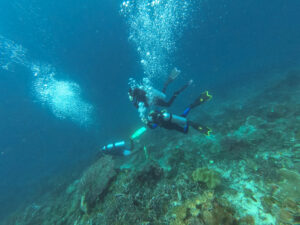What is a Full Foot Fin?
A full foot fin is a type of swim fin commonly used in scuba diving and snorkeling. This design covers the entire foot, providing a snug fit akin to wearing a shoe. Unlike open heel fins, which require additional footwear like neoprene boots, full foot fins are worn barefoot or with thin neoprene socks. They are especially popular for warm water diving and activities where divers need agility and speed in the water. Full foot fins are valued for their streamlined design, which offers less drag and more efficient energy transfer from the legs to the fins, enhancing propulsion and maneuverability underwater.
Historical Development
The origin of full foot fins can be traced back to the early 20th century when swimming and underwater exploration began gaining popularity. The first swim fins were simple, made of rubber, and designed to increase swimming speed. It wasn’t until the mid-20th century that fins evolved significantly, influenced by the burgeoning interest in scuba diving and snorkeling. Companies like Cressi and Mares, pioneers in diving equipment, played pivotal roles in developing more sophisticated and comfortable fins.
During the 1960s and 1970s, full foot fins saw significant advancements in design and materials. Manufacturers began experimenting with different types of rubber and plastic composites to enhance flexibility and durability. The introduction of split fins and channel designs in the blades marked a notable innovation, improving the efficiency of each kick. Over the decades, the design of full foot fins has continued to evolve, incorporating modern materials such as thermoplastic elastomers (TPE) and advanced silicone compounds, which offer superior performance and comfort.
Notable contributions to the development of full foot fins include the work of Luigi Ferraro, an Italian naval officer and diving equipment designer. Ferraro’s innovations in fin design, particularly his emphasis on ergonomics and hydrodynamics, significantly influenced modern fin technology. Today, full foot fins are the preferred choice for many recreational snorkelers and divers, thanks to their comfort, efficiency, and ease of use.
Design and Features
Full foot fins are characterized by their sleek, enclosed design that covers the entire foot. This design provides a secure and comfortable fit, minimizing the risk of fins slipping off during swimming. The foot pocket is typically made from soft, flexible materials that conform to the shape of the foot, providing both support and comfort. The blade, which extends from the foot pocket, is designed to maximize propulsion with minimal effort.
The structural design of full foot fins includes several key features. The foot pocket is usually constructed from a soft, pliable material such as rubber or silicone, ensuring a snug fit without causing discomfort. The blade, on the other hand, is made from more rigid materials like plastic or composite polymers. This combination allows the fin to harness the power of the leg muscles effectively, converting it into forward thrust.
When comparing full foot fins to open heel fins, several advantages become apparent. Full foot fins are generally lighter and more compact, making them ideal for travel. They also offer a more streamlined profile, reducing drag in the water and making them more efficient for swimming long distances. The absence of straps or buckles simplifies the process of putting on and taking off the fins, adding to their convenience.
Materials used in manufacturing full foot fins have evolved significantly. Early fins were made entirely of rubber, but modern fins often use advanced materials like thermoplastic elastomers (TPE), which offer a good balance of flexibility and rigidity. Some high-end models incorporate carbon fiber or fiberglass in the blade to enhance performance further. These materials are chosen for their ability to withstand the harsh conditions of underwater environments while maintaining their structural integrity and performance.
Full foot fins come in various sizes and colors, catering to a wide range of preferences and needs. Sizes are typically based on standard shoe sizes, ensuring a good fit for most users. The choice of colors is not just about aesthetics; bright colors can enhance visibility underwater, which is crucial for safety and coordination in group diving scenarios.
Mechanics and Functionality
The primary function of full foot fins is to enhance swimming efficiency by providing additional thrust with each kick. The mechanics behind this involve the principles of hydrodynamics, where the fin acts as an extension of the foot, increasing the surface area that pushes against the water. This increased surface area allows divers to move more quickly and with less effort compared to swimming without fins.
Full foot fins are particularly effective due to their design, which maximizes the transfer of energy from the diver’s legs to the water. The blade’s rigidity and shape are crucial factors in this process. Rigid blades provide more thrust but require more effort to use, while more flexible blades offer a balance of comfort and performance. The blade’s length and width also play a role, with longer blades generally providing more power but requiring more strength to use effectively.
Efficiency considerations for full foot fins include the type of kick used. The most common kick styles are the flutter kick and the frog kick. The flutter kick involves alternating leg movements, ideal for straight-line swimming and high-speed propulsion. The frog kick, which mimics the swimming motion of a frog, is more efficient for maneuvering and conserving energy. Full foot fins are well-suited to both styles, though their design often favors the flutter kick due to the streamlined nature of the fins.
Fit and comfort are essential factors in the functionality of full foot fins. A proper fit ensures that the fins stay securely on the feet without causing blisters or discomfort. Divers should choose fins that fit snugly but not too tightly. When trying on full foot fins, it is advisable to do so with the same type of socks or booties intended for use during diving. Ensuring a good fit helps prevent chafing and enhances overall performance.
Applications in Diving
Full foot fins are particularly popular in warm water diving environments. Their design, which allows for barefoot use, is ideal for tropical waters where additional thermal protection is not necessary. These fins are also favored for activities like snorkeling, where ease of use and comfort are paramount. Snorkelers often appreciate the lightweight and compact nature of full foot fins, which make them easy to pack and transport.
Recreational snorkeling is one of the primary applications for full foot fins. Their efficient design allows snorkelers to cover large areas with minimal effort, enabling them to enjoy extended periods in the water without excessive fatigue. The streamlined profile of full foot fins reduces drag, making it easier to navigate through the water and observe marine life.
In addition to snorkeling, full foot fins are widely used in free diving. Free divers, who rely on holding their breath rather than using scuba equipment, benefit from the propulsion and efficiency provided by full foot fins. These fins allow free divers to descend and ascend quickly, conserving their energy and breath-hold time. The snug fit and lightweight nature of full foot fins are advantageous in this discipline, where every movement must be optimized.
While full foot fins are advantageous in many scenarios, there are some limitations and safety considerations to keep in mind. They are generally not suitable for cold water diving, where additional thermal protection for the feet is necessary. The lack of an adjustable strap means that they might not fit as securely as open heel fins with booties, especially in strong currents or rugged underwater environments. Divers should also be cautious about using full foot fins in areas with sharp rocks or coral, as the lack of foot protection can lead to injuries.
Maintenance and Care
Proper maintenance and care of full foot fins are essential to ensure their longevity and performance. After each use, fins should be rinsed thoroughly with fresh water to remove salt, sand, and other debris. This helps prevent the materials from degrading and maintains the fin’s flexibility and strength. It is particularly important to clean the foot pocket, as trapped debris can cause discomfort and damage.
To address common issues such as tears or warping, divers should inspect their fins regularly for signs of wear and damage. Small tears can often be repaired with specialized adhesives designed for rubber and plastic materials. However, significant damage may require professional repair or replacement. Warping, which can occur if fins are exposed to high temperatures or direct sunlight for extended periods, can often be mitigated by storing fins in a cool, dry place away from direct sunlight.
When storing full foot fins, it is advisable to keep them in a flat position to prevent warping. Avoid placing heavy objects on top of the fins, as this can distort their shape. Some divers prefer to store their fins in a mesh bag, which allows air circulation and helps them dry more quickly. Proper storage practices help maintain the structural integrity of the fins and ensure they are ready for use on the next dive.
Comparative Analysis
When comparing full foot fins to other types of diving fins, several factors come into play. Full foot fins are generally lighter and more compact than open heel fins, making them ideal for travel and warm water environments. They offer a streamlined profile, reducing drag and enhancing swimming efficiency. The absence of straps and buckles also simplifies their use, making them a convenient option for many divers.
Open heel fins, on the other hand, are typically preferred in cold water diving or environments where additional foot protection is necessary. These fins are designed to be worn with neoprene boots, providing thermal insulation and protecting the feet from sharp objects. Open heel fins also offer more adjustability, allowing for a secure fit even in challenging conditions. However, they tend to be bulkier and heavier, which can be a drawback for travel.
Cost is another factor to consider. Full foot fins are often less expensive than open heel fins, primarily due to their simpler design and materials. This makes them an attractive option for beginner divers or those on a budget. Durability is also a consideration; while both types of fins are built to withstand underwater conditions, the additional components of open heel fins (straps, buckles) may require more frequent maintenance and replacement.
Ultimately, the choice between full foot fins and other types of fins depends on the diver’s specific needs and preferences. For warm water diving, snorkeling, and free diving, full foot fins offer a combination of comfort, efficiency, and convenience. In contrast, open heel fins are better suited for cold water environments and situations where foot protection and adjustability are paramount.
Key Takeaways
Full foot fins are an essential piece of equipment for divers and snorkelers, offering a combination of comfort, efficiency, and ease of use. Their design, which covers the entire foot, provides a secure fit and enhances propulsion in the water. While particularly well-suited for warm water environments and recreational activities, they require proper maintenance and care to ensure longevity. Comparing full foot fins with other types highlights their unique advantages and the specific contexts in which they excel.

